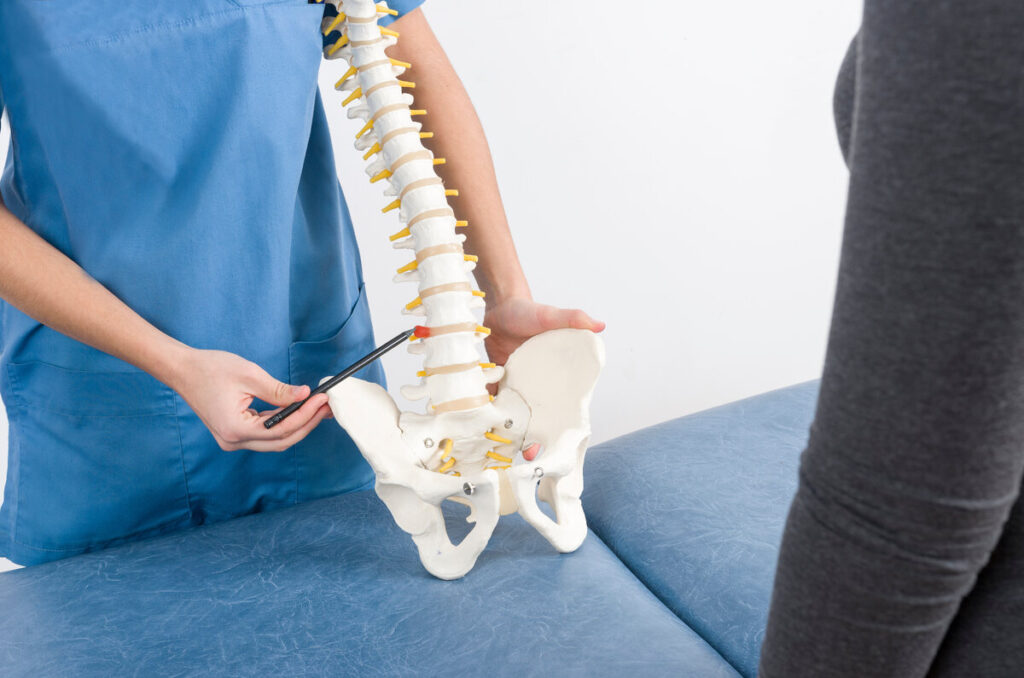
A thoracic herniated disc occurs when the inner material of a spinal disc pushes through its outer layer in the mid-back region. Unlike cervical or lumbar herniations, which are more common, thoracic disc issues are relatively rare but can cause significant discomfort. Thoracic herniated disc symptoms may include localized mid-back pain, radiating discomfort, or neurological changes, depending on the severity of the condition. Thoracic herniated discs can be caused by age-related degeneration, injury, repetitive strain, heavy lifting, or underlying conditions such as osteoporosis. When they receive a diagnosis, many people want to know if their thoracic herniated disc requires surgery. More often than not, a thoracic herniated disc can heal without surgery, but access to high-quality care is essential.
What Does a Thoracic Herniated Disc Feel Like?
The most common thoracic herniated disc symptoms include mid-back pain that may radiate around the chest or abdomen. Some patients experience numbness or tingling in the torso or lower extremities. In more severe cases, neurological symptoms such as muscle weakness, difficulty with coordination, or even changes in bowel and bladder function may appear. These are red flags requiring urgent medical evaluation.
It’s also important to understand that symptoms can vary greatly depending on the severity and exact location of the herniation. For some, discomfort may present gradually, while others may experience a sudden onset after an injury or strain. Pain can also worsen with certain movements, prolonged sitting, or poor posture, making daily activities more difficult. Because thoracic disc issues are relatively rare and sometimes mimic other conditions, obtaining an accurate diagnosis from an experienced spine specialist is critical. Recognizing the symptoms of a herniated disc early allows for timely intervention and improved recovery outcomes, helping patients avoid long-term complications and return to normal function.
How Long Does It Take for a Thoracic Disc Herniation to Heal?
Patients’ experiences of healing from a thoracic disc herniation vary widely. With conservative care, many improve within weeks to months, while others may take longer. Age, overall health, and severity of the herniation all influence outcomes.
Encouragingly, improvement is possible even over longer timelines. Patients often ask, “Can a bulging disc heal after 2 years?” The answer is yes. In fact, in some cases, symptoms may continue to lessen with sustained care and healthy habits. It is important to track progress and pay attention to signs that a herniated disc is healing, such as reduced pain, improved mobility, and fewer neurological issues. Individualized thoracic herniated disc treatment can further help to guide realistic expectations for recovery.
How Do You Treat a Herniated Disc in the Thoracic Spine?
Although most cases of thoracic herniated discs do not require surgery, certain steps should be taken for a proper recovery. Nonsurgical approaches include rest, activity modification, medications, and physical therapy. Interventional pain management physicians at Goodman Campbell specialize in designing personalized care plans that emphasize conservative therapies.
Posture adjustments, ergonomic work setups, and guidance on how to sleep with a thoracic herniated disc can also make a significant difference in symptom relief.
In addition to these measures, patients may benefit from structured exercise programs to strengthen the supporting muscles of the spine, as well as lifestyle modifications such as weight management and improved nutrition to reduce stress on the discs. Mind-body strategies, including stress reduction techniques and gentle stretching, can further support healing. For patients needing more advanced care, minimally invasive procedures such as targeted injections are available to relieve pain and restore function.
Surgery is reserved for rare cases where symptoms persist or neurological complications worsen. You can access every level of care through comprehensive thoracic herniated disc treatment at Goodman Campbell.
How To Heal a Thoracic Bulging Disc Naturally
Many people want to know how to heal a herniated disc quickly without surgery. While there’s no overnight fix, self-care plays a major role in recovery. Gentle stretching and strengthening exercises can support the spine, while a balanced diet and weight management reduce strain on discs. Staying hydrated keeps discs supple, and maintaining good posture lowers the risk of further injury. Regular activity — avoiding long periods of immobility — supports healing and overall spinal health.
Monitoring for signs that a herniated disc is healing, such as decreased pain and improved flexibility, can provide encouragement. Working closely with a healthcare team ensures that natural approaches are safe and effective as part of a comprehensive thoracic herniated disc treatment plan.
Hope for Healing and Next Steps
For many patients, a thoracic herniated disc can improve significantly with nonsurgical care. Recovery requires time, persistence, and partnership with trusted specialists. Noticing signs that a herniated disc is healing can help patients stay motivated, while innovative options make thoracic herniated disc treatment more effective than ever. Patients exploring thoracic herniated disc treatment in Indiana will benefit from specialists who provide personalized recovery strategies based on individual health needs.
At Goodman Campbell, patients find expert care and compassionate support throughout their journey. If you or a loved one is experiencing thoracic herniated disc symptoms, take the first step: ask your doctor about Goodman Campbell and explore your personalized path to recovery.


